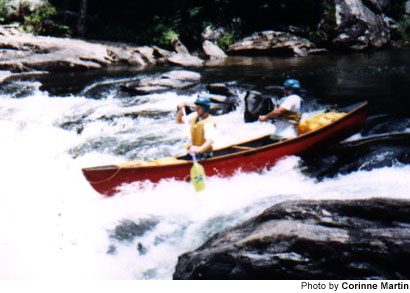
“You know what I was just thinking? The first explorers saw this country, saw it just like us — in a canoe.”
Lewis Medlock (Burt Reynolds) in the 1972 motion picture “Deliverance”
July 6, 1999 — The Chattooga River is a natural dichotomy. Charming and challenging. Delightful and deadly.
Perfect for paddlers, who often surf the slippery slope between sane and insane — and call it a good time.
“It’s just plain fun,” said Dennis Martin as we drove past a sign advertising boiled peanuts along U.S. 76. “It’s thrilling, and it can be the ultimate roller-coaster ride. But between rapids, it’s beautiful out there.
“You’ll see.”
Yes, I would see, from the bow seat of an open tandem whitewater canoe. And I couldn’t wait. We crossed the U.S. 76 bridge into South Carolina. We were almost there.
Like many outsiders, I was first introduced to the Chattooga by the 1972 film “Deliverance.” John Voight, Burt Reynolds and Ned Beatty received top billing in the thriller, but the beautiful, unbridled river was the movie’s true star.
“Deliverance” let the world know what folks in the Southeast knew all along — that one of the top free-flowing whitewater streams in all of the United States is also the northernmost border between Georgia and South Carolina.
And it’s not pronounced Chattooga, either. Local paddlers drop the “a” from the end. Well, at least Dennis and Corinne Martin do. And I’ll take their word over anybody’s.
The Gainesville couple has paddled the “Chattoog” hundreds of times. And they keep coming back, again and again.
“You never conquer a river,” offered Corinne as we approached our put-in point at Thrift’s Ferry, about two miles north of the U.S. 76 bridge.
No, the Martins won’t ever conquer the Chattooga, but it certainly won’t be for a lack of trying. Little has kept the 48-year-olds from the river’s roaring rapids over the past 18 years. A mother of three, Corinne once paddled the Chattooga while eight months pregnant.
During the early months of the year, when the river is at its whitewater best, Corinne makes the short 75-minute drive from Gainesville to canoe the Chattooga on a weekly basis.
The heavy rains of June made the Chattooga unseasonably swift — and our visit Saturday a must.
“You have to jump on it while you can,” said Dennis, a senior forester with the state of Georgia.
So we did, Dennis and I taking off in our tandem and Corinne in her open whitewater canoe.
From Thrift’s Ferry, we were greeted by a relatively long stretch of Class I-II (easy to intermediate) water. This allowed Dennis some time to review the canoeing basics he taught me on Lake Lanier the evening before, and it allowed Corinne some time to play.
She paused for a moment in one of the river’s calmer sections behind a large rock. Then she re-entered the current, pirouetting across the rapids, again landing in a placid pool blocked by an obstruction. She called this eddy hopping, but she made it seem much more graceful than that.
“Has your wife ever been a dancer?” I asked Dennis.
“Only on the water,” he replied with a smile.
Playtime ended abruptly as Bull Sluice, one of the Chattooga’s most treacherous rapids, made its presence known up ahead of us.
We pulled out well above a set of large boulders jutting out from the Georgia side of the river to scout this Class V (exceedingly difficult) monster. Well, Dennis and Corrine scouted it at least. I had no business even considering riding this Bull.
Bull Sluice plunges paddlers 12-feet over two consecutive drops. The second of which flows violently between a narrow passage created by the boulders on the right and a large, sharp rock in the middle of the river comfortingly known as Decapitation Rock.
The Martins first tackled it with the tandem. Then Corinne went back and did it again in the single. They never stopped smiling.
We continued on, passing under the U.S. 76 bridge, the last and only sign of modern civilization along our picturesque route. The Chattooga, designated a Wild and Scenic River by Congress in 1974, begins in the mountains of North Carolina and ends 57-miles later in Lake Tugaloo, dropping nearly one-half mile in elevation along the way.
The Chattooga’s setting is primitive, seemingly untouched. And to experience the river’s wild wonders in the same manner it had been done hundreds of years before — kneeling in canoe — felt fitting. I realized then why the Martins kept smiling.
The river began to narrow and the drops became more frequent. We were entering Section IV of the Chattooga, the seven-mile stretch that keeps the nation’s whitewater enthusiasts coming back for more.
We were greeted by Screaming Left Turn, a Class IV (very difficult) rapid featured prominently in “Deliverance.” A half mile later, we negotiated the Class III (difficult) Rock Jumble.
Then the river suddenly became calm, which for the paddler is an ominous sign — kind of like the plucks of a banjo in a scary movie — that rough waters lie ahead. And they did, in the form of Woodall Shoals (Class VI, utmost difficulty), perhaps the most dangerous rapid on the river.
We avoided the killer hydraulic, by taking the “sneak route,” a rocky five-foot drop, to its right. Fifty fun yards of Class III water took us to a large pool and our take-out point.
I waded out into the pool and just floated there, taking in my majestic surroundings.
Ah, the Wild and Scenic Chattooga River. No Ned Beatty. No dueling banjos.
Just plain fun.
Enough fun to make you want to squeal — squeal like a piggy.
